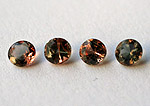andalucite
斜方晶系の珪酸塩鉱物 硬度7.5 比重3.15-3.17 屈折率1.634-1.641; 1.644-1.648 分散度0.016
アンダリュサイトはスペインのアンダルシアで最初に発見された化学式Al2SiO5のアルミニウムの珪酸塩鉱物で、カイヤナイト及びフィブロライトと同質異像です。緑がかった褐色、あるいは緑色をしており、黄、緑、赤の顕著な多色性を示します。主要な産地はブラジル、サンタ・テレサ(エスピリト・サント州)近郊の幅15km長さ40kmの範囲です。水流に運ばれて摩滅した小石として見つかるため、ほとんどの場合小粒で、5カラットを超える大きさのものはきわめて稀です。ブラジルの石はテーブル面を光軸に対してほぼ直角にとってカットすることにより、肉色に近い赤とオリーヴ色に近い緑の非常に強い多色性を示します。
不純物を多く含む不透明のアンダリュサイトには、十字型に配置された炭素質のインクルージョンを有し、カイアストライトと呼ばれるものがあります。これらはその十字架状の模様ゆえにピレネー地方を中心に護符として珍重されています。
Andalucite
Aluminium silicate Al2SiO5 in orthorombic system, Mohs’s scale 7.5, specific gravity 3.15 to 3.17, variant refractive indeces from 1.634 to 1.641 to 1.644 to 1.648, dispersion 0.016
Andalucite, an aluminium silicate polymorphous with kyanite and fibrolite, derives its name from Andalucia where it was first discovered and exhibits an extremely strong pleochroism of yellow, green, and red. The most prolific source of the gem is secondary deposits in an area some 15km wide and 40km long near Santa Teresa in the state of Espirito Santo, Brazil. Most of the gem mineral is found as water-worn pebbles, thus making bigger stones over 5 carats quite rare. The Brazilian stones, when cut with the table facet nearly at right angles to the vertical axis of the crystal, shows a very conspicuous pleochroism of strong flesh-red and olive-green. An impure opaque variety of the mineral containing carbonaceous inclusions with a cruciform arrangement is known as chiastolite (from Greek χιαστός "cross-shaped" and -lite λίθος "stone"). Chiastolite crystals, sections of which are polished and made into amulets and charms due to its appearance similar to a cross, are popular in such places as the Pyrenées where religious significance of the cross is profound.
 Brazilian andalucite ブラジル産 アンダリュサイト 1.43cttw 残り3個
Brazilian andalucite ブラジル産 アンダリュサイト 1.43cttw 残り3個 稀少石 Brazilian andalucite ブラジル産 アンダリュサイト 6 x 4 mm 二個で 0.79 カラット
稀少石 Brazilian andalucite ブラジル産 アンダリュサイト 6 x 4 mm 二個で 0.79 カラットその他の宝石 商品種別表示インデックスに戻る
ダイヤモンドとその他の宝石 一覧表示インデックスに戻る
ルース(裸石) 商品種別表示インデックスに移動する
宝石とジュエリー 商品種別表示インデックスに移動する
アンティークアナスタシア ウェブサイトのトップページに移動する
Ἀναστασία ἡ Οὐτοπία τῶν αἰλούρων ANASTASIA KOBENSIS, ANTIQUARUM RERUM LOCUS NON INVENIENDUS